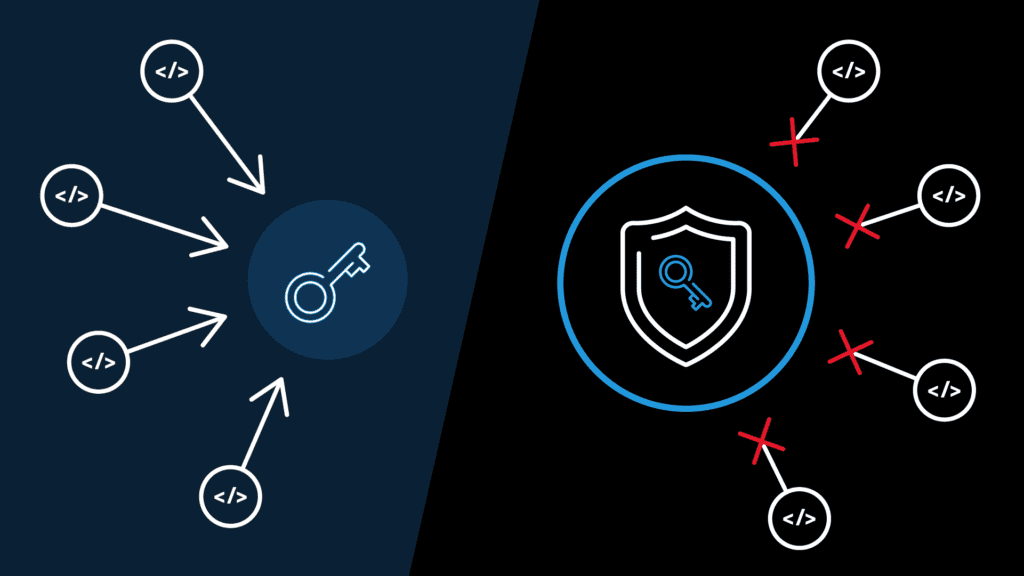Report Overview
The market for passwordless authentication was estimated at USD 12.26 billion globally in 2021, and it is anticipated to increase at a CAGR of 18.2% from 2022 to 2030. Passwordless authentication is a security technique that makes use of unique biological qualities, such as voice analysis, iris recognition, fingerprint recognition, face recognition, and others, as well as personal identification numbers, security tokens, and other means. Due to improved security and the ease of accessing data from anywhere, passwordless authentication techniques are still becoming more and more common. As an illustration, WinMagic declared the availability of MagicEndpointTM, its passwordless authentication and encryption solution, in June 2022. With Magic Endpoint, WinMagic joined the password-less market and offered data and user security solutions for authentication and encryption. With the help of the solution, CISOs and other IT security and technology experts can swiftly adopt passwordless authentication, meeting their needs for cyber security while removing password hassle and cutting costs associated with password management.
By moving verification to the device rather than sending credentials via an online connection, passwordless technology changes the fundamental security architecture. Although passwordless systems are more advanced, traditional multi-factor authentication (MFA) still provides security and convenience to the authentication process. It’s common for businesses to try to balance supply chain security, which is crucial for B2B financial infrastructure, with user experience and workforce access security.
Such security solutions are still in high demand in the industry. Many businesses are still committed to helping SMEs overcome the hurdles of digitalization and financial infrastructure. For instance, Arculix, a cutting-edge passwordless authentication and identity orchestration platform, was introduced in June 2022 by SecureAuth Corporation, a provider of identity access management security solutions. Enterprises can create frictionless and secure experiences for IDs everywhere thanks to the new platform.
Weak and reused passwords are responsible for over 81% of hacking-related breaches, according to Verizon’s data breach investigations report (DBIR) for June 2022. The banking industry is moving towards passwordless authentication as an additional layer of security for their clients’ accounts because more than 90% of consumers reuse passwords for both work and personal accounts. There are many ways to lower risk in IT, but this is where professional security professionals are mostly focused. Passwordless authentication solutions are increasingly being employed in the banking industry due to the vulnerability of passwords and the possibility of password theft.
Component Insights
In 2021, the hardware sector dominated the market with a revenue share of almost 63%. Users can use cryptographically secure hardware to perform multi-factor authentication through hardware-based security devices. Biometric systems, smart cards, tokens, key fobs, wristbands, and mobile solutions are among the hardware components used in passwordless authentication. Businesses may utilise their software and hardware with ease knowing that their data is secure and compliant with international security standards.
For instance, hardware authentication device maker Yubico unveiled the YubiKey Bio in October 2021. This was the company’s first biometric authentication key for passwordless logins and multi-factor authentication. A fingerprint reader is incorporated into the new hardware key from the company for password-free authentication.
Software solutions for password-free authentication include those from IBM (IBM Security Verify), Fujitsu (AuthConductor), and Thales (SafeNet Authentication Client). Businesses protect their customer and business data on mainframe computers, data servers, workstations, Wi-Fi routers, facility doors, and other locations with authentication software.
For instance, the software-as-a-service WorkforceID Authentication was fully released by HID Global Corporation in April 2021. Companies can use the solution’s cloud-based platform to issue, manage, and use digital identity credentials for logical and physical access control. With easy connectivity to Microsoft’s on-premise or cloud Active Director systems, HID WorkforceID Authentication enables enterprises to simplify, automate, and secure logins by all users to all apps inside the enterprise environment.
Product Type Insights
With almost 29% of the total market’s revenue coming from the fingerprint authentication sector in 2021, it was the market leader. The prevalence of fingerprint sensors used for authentication in consumer devices, the growing use of biometric authentication in government offices, and the introduction of touchless fingerprint technology solutions are the key causes of this. Digital banking is safer and more manageable thanks to fingerprints’ modernization of the authentication stack. The segment expands further with the effective application of biometric time and attendance systems for evaluating employee productivity, work hours, and other factors.
In the upcoming years, it is projected that the face recognition market would experience rapid expansion. The sector’s significant rise can be ascribed to the growing adoption of face recognition technology by law enforcement. Especially at airports, border officials are increasingly using facial recognition technology to verify people’ identities. Smartphones are another area where the technology has been widely used, including for payment verification, phone unlocking, and signing into mobile apps
For instance, Symisc Systems, SUARL’s PixLab service introduced FaceIO in September 2022. This web-based facial authentication framework was created to authenticate users using face biometrics rather than conventional passwords and login pairs or one-time password (OTP) tokens. It may be integrated on any webpage via JavaScript.
Authentication Type Insights
In 2021, the single-factor authentication market accounted for more than 60% of total revenue. By identifying the party requesting access using just one sort of credential, single-factor authentication protects access to a particular system, such as a website or network. The likelihood of credentials being lost, exchanged, or stolen is reduced as manufacturers create more secure biometric solutions with extremely advanced features that offer scalable identity-based access.
For instance, Teleport 10, the most recent version of its Teleport Access Plane service, was made available in July 2022 by Gravitational Inc., a developer of identity-based infrastructure access management solutions. Using a single sign-on infrastructure, passwordless access eliminates the need for private keys, passwords, usernames, and other security information in Teleport 10.
In the upcoming years, it is projected that multi-factor authentication would experience significant increase. Greater identity theft and breaches, increased IoT device use, and stricter government laws are all factors in the segment’s rise. Organizations all across the world are employing more stringent identity verification procedures to safeguard sensitive data stored there against fraud. Such theft and fraud occurrences function as a warning for companies to adopt multi-factor authentication tools and services.
For instance, the launch of ReACT MFA, a new multi-factor authentication (MFA) technology, was announced by Advanced Software Products Group in September 2022. As a secondary authentication source, ReACT MFA verifies end users and authorises access to data, protecting resources and reducing their susceptibility to attack.
Portability Insights
With almost 65% of the market, the fixed sector held the top spot in 2021. The substantial biometric infrastructure used for time management and attendance systems, such as in the business sector, is responsible for the segment’s rise. For instance, the global technology giant Cisco Systems Inc. announced passwordless authentication through the Duo security platform in March 2021. The product’s infrastructure independence lays the groundwork for a password-free future and ensures that businesses can simply secure any combination of cloud and on-premises apps without the need for many authentication solutions or opening significant security holes.
In the upcoming years, it is projected that the mobile market would experience rapid expansion. Mobile authentication systems use one or more biometric modalities for identification or authentication and allow for flexible deployment using tablets, smartphones, other handheld devices, wearable technology, and IoT devices. Since they do not require the same extensive installation as fixed authentication systems, mobile authentication systems are also simple to move. These systems frequently have features like Wi-Fi and remote control that let a user control and monitor the device from places other than its actual location. The system’s properties that cause this segmentation are to blame.
End-user Insights
With a market share of almost 18% in 2021, the government sector held the top spot. Given that internet services are becoming the main means of contact between citizens and their governments, the government is heavily investing in digital programmes. A number of government agencies are rethinking their national authentication procedures because of the serious issue with the security of digital government services.
The Reserve Bank of India (RBI) published its “Master Direction on Digital Payment Security Controls” in February 2021, requiring regulated companies in the banking, FinTech, payments, and cryptocurrency sectors to incorporate “dynamic or non-replicable” security mechanisms to authenticate user transactions.
In the years ahead, it is projected that the BFSI segment would experience rapid expansion. By allowing consumers access to more formerly password-protected information, financial institutions can scale their passwordless authentication to greater heights. This enables both wider access and better productivity per employee. In May 2022, the financial technology company Bonifii expanded its biometric authentication method for credit unions to include context-aware passwordless authentication technology enabled by Entersekt, a fintech supplier of mobile-based authentication and app security software, and it selected a MasterCard affiliate as the authorised open banking provider for MemberPass, its certified biometric digital identity service.
Regional Insights
With a 39% plus share of global revenue in 2021, North America led the market. The market is expanding due to a number of benefits, including as enhanced user experience, higher security, cheaper total cost of ownership, and rising investments in developed nations like the United States, Canada, and Mexico for the usage of passwordless authentication technology. Additionally, the region has seen a rise in passwordless authentication due to rising data security concerns in these nations. The market is growing as a result of this region’s increasing use of technologies like artificial intelligence (AI) and the internet of things (IoT).
From 2022 to 2030, Asia Pacific is predicted to have the fastest CAGR, at 21.0%. This increase can be ascribed to the rising use of smartphones and tablets in this area as well as technologies like facial and fingerprint identification, which are major growth drivers for the local passwordless authentication industry.
Key Companies & Market Share Insights
- ASSA ABLOY
- DERMALOG Identification Systems GmbH
- East Shore Technology, LLC
- Fujitsu
- HID Global Corporation
- M2SYS Technology
- Microsoft
- NEC Corporation
- Safran
- Thales.
Global Passwordless Authentication Market Segmentation
This study provides an analysis of the most recent market trends in each of the sub-segments from 2017 to 2030 and estimates revenue growth at the global, regional, and national levels. According to component, product type, authentication type, portability, end-user, and geography, Flair Insights has divided the global passwordless authentication market report into segments for this study:
- Component Outlook (Revenue, USD Billion, 2017 – 2030)
- Hardware
- Software
- Services
- Product Type Outlook (Revenue, USD Billion, 2017 – 2030)
- Fingerprint Authentication
- Palm Recognition
- Iris Recognition
- Face Recognition
- Voice Recognition
- Smart Card
- Others
- Authentication Type Outlook (Revenue, USD Billion, 2017 – 2030)
- Single-factor Authentication
- Multi-factor Authentication
- Portability Outlook (Revenue, USD Billion, 2017 – 2030)
- Fixed
- Mobile
- End-user Outlook (Revenue, USD Billion, 2017 – 2030)
- IT & Telecom
- Retail
- Transportation & Logistics
- Aerospace & Defence
- BFSI
- Healthcare
- Government
- Others
- Regional Outlook (Revenue, USD Billion, 2017 – 2030)
- North America
- U.S.
- Canada
- Mexico
- Europe
- Germany
- U.K.
- France
- Asia Pacific
- China
- India
- Japan
- Central & South America
- Brazil
- Middle East and Africa (MEA)
- North America



